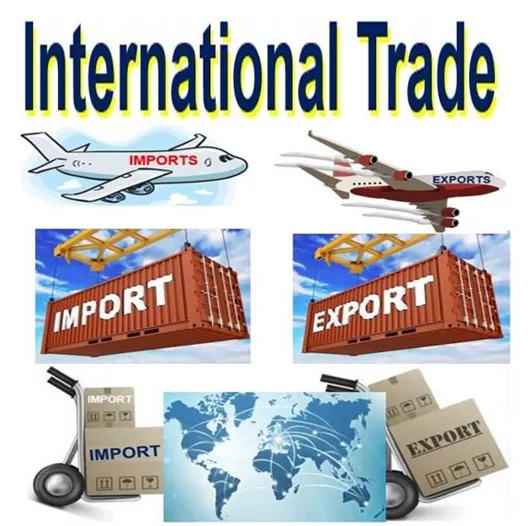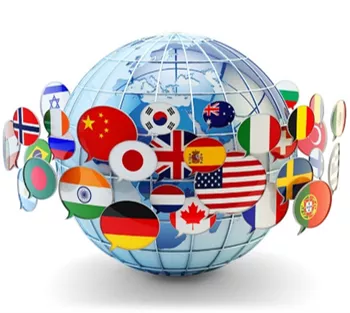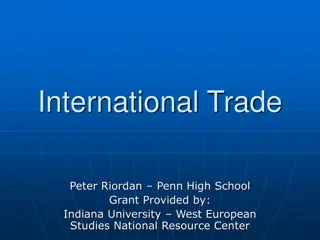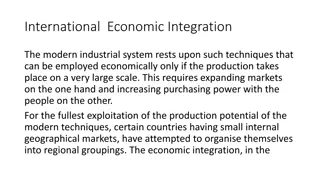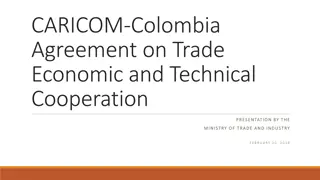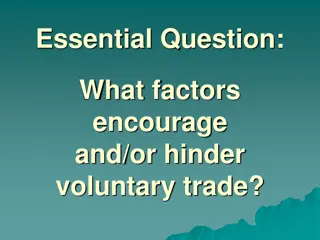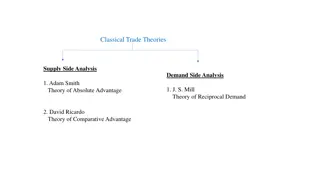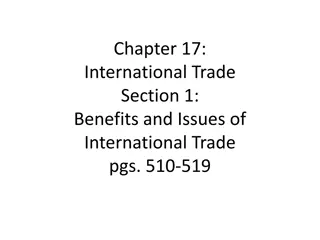Understanding Global Trade Economics: Benefits, Specialization, and Barriers
Global trade plays a crucial role in benefiting all participating parties through specialization, absolute, and comparative advantage. Nations trade to increase overall output and foster economic growth, leading to greater world output and increased political stability. However, governments may restrict trade through tariffs, quotas, embargoes, inspections, and licenses to protect domestic industries.
Download Presentation

Please find below an Image/Link to download the presentation.
The content on the website is provided AS IS for your information and personal use only. It may not be sold, licensed, or shared on other websites without obtaining consent from the author. Download presentation by click this link. If you encounter any issues during the download, it is possible that the publisher has removed the file from their server.
E N D
Presentation Transcript
RESOURCES FOR GLOBAL TRADE Economics| Chapter 17
ESSENTIAL QUESTION How does trade benefit all participating parties?
I. ABSOLUTE AND COMPARATIVE ADVANTAGE A. Why Nations Trade Nations trade for the same reasons that individuals do because they believe that the products they receive are worth more than the products they give up. How does trade allow for specialization? 1) Specialization When people specialize, they produce the things they do best and exchange those products for the things other people do best. To see what a country specializes in you look at its exports To see what it does not produce efficiently look at its imports 2) Extent of Trade The United States imports about $7,550 per person in goods and services
I. ABSOLUTE AND COMPARATIVE ADVANTAGE B. The Basis for Trade How does trade result in greater overall output? Absolute Advantage when a country can produce more of a product than another country 1. 2. Comparative Advantage the ability to produce a product relatively more efficiently, or at a lower opportunity cost.
I. ABSOLUTE AND COMPARATIVE ADVANTAGE C. The Gains from Trade 1. Greater World Output The concept of comparative advantage is based on the assumption that everyone will be better off by specializing in the products they produce best. Because each country has a comparative advantage in a product the other country wants, trade will be beneficial to both and will lead to economic growth. 2. Increased Political Stability Economists argue that cooperation in international economic affairs precedes political cooperation. 3. Faster Economic Growth The gains from trade also help an economy to grow. The growth comes from two sources: a bigger market for the country s manufactured goods and services, and the ability to secure needed inputs for production.
A. Restricting International Trade Why does the government place restrictions on international trade? Tariffs a tax placed on imports to increase their price in the domestic market. A protective tariff is a tariff high enough to protect less- efficient domestic industries. The revenue tariff is a tariff high enough to generate revenue for the government without actually prohibiting imports. Quotas a limit placed on the quantities of a product that can be imported. Foreign goods sometimes cost so little that even a high tariff on them might not protect the domestic market, so governments will use quotas A. 1) II. BARRIERS TO INTERNATIONAL 2) TRADE B.
A. Restricting International Trade C. Other Barriers 1) Embargos Sometimes a country will place an embargo, or a government order prohibiting the movement of goods to a country 2) Inspections Many imported foods are subject to health inspections that are far more rigorous than those given to domestic foods. 3) Licenses Another effective method is to require a license to import. If the government is slow to grant the license, or if the license fees are too high, international trade is restricted. 4) Health concerns Some nations use health issues to restrict trade. Several European countries, for example, refuse to import genetically altered crops grown in the United States. 5) Nationalism and culture Cultural factors also play a role as a trade barrier. II. BARRIERS TO INTERNATIONAL TRADE
B. Arguments for Protection Protectionists are people who favor trade barriers to protect domestic industries. Free traders, prefer fewer or even no trade restrictions. Aiding National Defense Protectionists argue that without trade barriers, a country could become so specialized that it would end up becoming too dependent on other countries. Free traders believe that the advantages of having a reliable source of domestic supply must be weighed against the disadvantages that the supply will be smaller and possibly less efficient than it would be with free trade. Promoting Infant Industries The infant industries argument that new or emerging industries should be protected from foreign competition is also used to justify trade barriers. 1) II. BARRIERS TO INTERNATIONAL TRADE 2)
B. Arguments for Protection Protecting Domestic Jobs A third argument and the one used frequently is that tariffs and quotas protect domestic jobs from cheap foreign labor. In the short run, protectionist measures provide temporary protection for some domestic jobs. When inefficient industries are protected, the economy produces less and the standard of living goes down. Keeping Money at Home Another argument for trade barriers claims that limiting imports will keep American money in the United States instead of allowing it to go abroad. Free traders, however, point out that the American dollars that go abroad generally come back again 3) II. BARRIERS TO INTERNATIONAL TRADE 4)
B. Arguments for Protection Helping the Balance of Payments Protectionists argue that restrictions on imports reduce trade deficits and thus help the balance of payments. Most economists do not believe that interfering with free trade can be justified on the grounds of helping the balance of payments. National Pride A final argument for protection is national pride. (Harley- Davidson) If the protection is permanent, then the government is simply protecting inefficient producers. 5) II. BARRIERS TO INTERNATIONAL TRADE 6)
C. The Free Trade Movement The use of trade barriers to protect domestic industries and jobs works only if other countries do not retaliate with their own trade barriers. Tariffs During the Great Depression In 1930, the United States passed the Smoot-Hawley Tariff Act, one of the most restrictive tariffs in history. It set import duties so high that the prices of many imported goods rose nearly 70 percent. When other countries did the same, international trade nearly came to a halt. As a result, in 1934 the United States passed the Reciprocal Trade Agreements Act, which allowed it to reduce tariffs up to 50 percent if other countries agreed to do the same. 1) II. BARRIERS TO INTERNATIONAL TRADE
C. The Free Trade Movement 2) The World Trade Organization In 1947, 23 countries signed the General Agreement on Tariffs and Trade (GATT). Under GATT, nations agreed to extend tariff concessions and worked to eliminate import quotas. The World Trade Organization (WTO), an international agency that enforces trade agreements signed under GATT and settles trade disputes between nations. 3) NAFTA The North American Free Trade Agreement (NAFTA) is an agreement to liberalize free trade by reducing tariffs and quotas among three major trading partners: Canada, Mexico, and the United States. NAFTA is the world s largest free trade area. The area now links over 470 million people who produce about $19 trillion of goods and services. II. BARRIERS TO INTERNATIONAL TRADE
A. Financing International Trade How are flexible exchange rates and fixed exchange rates different? In the field of international finance, foreign exchange different currencies used to facilitate international trade are bought and sold in the foreign exchange market. The foreign exchange rate is the price of one country s currency in terms of another country s currency. 1) Fixed Exchange Rates a system under which the price of one currency is fixed in terms of another currency so that the exchange rate does not change. Fixed exchange rates were popular when the world was on a gold standard. III. FOREIGN EXCHANGE AND TRADE DEFICITS
A. Financing International Trade 2) Flexible Exchange Rates Under flexible exchange rates, also known as floating exchange rates, the forces of supply and demand establish the value of one country s currency in terms of another country s currency. Whenever the dollar falls in value, exports tend to go up and imports go down. If the dollar rises, the reverse will occur. III. FOREIGN EXCHANGE AND TRADE DEFICITS
B. Trade Deficits and Surpluses III. FOREIGN EXCHANGE AND TRADE DEFICITS How does the strength of the dollar affect U.S. trade deficits? A country has a trade deficit whenever the value of the products it imports exceeds the value of the products it exports. It has a trade surplus whenever the value of its exports exceeds the value of its imports.
B. Trade Deficits and Surpluses 1) International Value of the Dollar When the dollar is strong, foreign goods become less costly and American exports become more costly for the rest of the world. As a result, imports rise, exports fall, and trade deficits result. With more dollars going abroad, the value of the dollar then goes down III. FOREIGN EXCHANGE AND TRADE DEFICITS 2) Effects of a Trade Deficit 1) A persistent trade imbalance can cause a chain reaction that affects income and employment.
III. FOREIGN EXCHANGE AND TRADE DEFICITS B. Trade Deficits and Surpluses 1) International Value of the Dollar 2) Effects of a Trade Deficit 3) A Strong vs. a Weak Dollar

 undefined
undefined











